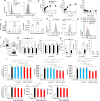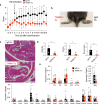TARM1 contributes to development of arthritis by activating dendritic cells through recognition of collagens
- PMID: 33397982
- PMCID: PMC7782728
- DOI: 10.1038/s41467-020-20307-9
TARM1 contributes to development of arthritis by activating dendritic cells through recognition of collagens
Abstract
TARM1 is a member of the leukocyte immunoglobulin-like receptor family and stimulates macrophages and neutrophils in vitro by associating with FcRγ. However, the function of this molecule in the regulation of the immune system is unclear. Here, we show that Tarm1 expression is elevated in the joints of rheumatoid arthritis mouse models, and the development of collagen-induced arthritis (CIA) is suppressed in Tarm1-/- mice. T cell priming against type 2 collagen is suppressed in Tarm1-/- mice and antigen-presenting ability of GM-CSF-induced dendritic cells (GM-DCs) from Tarm1-/- mouse bone marrow cells is impaired. We show that type 2 collagen is a functional ligand for TARM1 on GM-DCs and promotes DC maturation. Furthermore, soluble TARM1-Fc and TARM1-Flag inhibit DC maturation and administration of TARM1-Fc blocks the progression of CIA in mice. These results indicate that TARM1 is an important stimulating factor of dendritic cell maturation and could be a good target for the treatment of autoimmune diseases.
Conflict of interest statement
The authors declare no competing interests.
Figures





Similar articles
-
TARM1 Is a Novel Leukocyte Receptor Complex-Encoded ITAM Receptor That Costimulates Proinflammatory Cytokine Secretion by Macrophages and Neutrophils.J Immunol. 2015 Oct 1;195(7):3149-59. doi: 10.4049/jimmunol.1401847. Epub 2015 Aug 26. J Immunol. 2015. PMID: 26311901 Free PMC article.
-
Antigen-specific immunomodulation of collagen-induced arthritis with tumor necrosis factor-stimulated dendritic cells.Arthritis Rheum. 2004 Oct;50(10):3354-64. doi: 10.1002/art.20513. Arthritis Rheum. 2004. PMID: 15476255
-
Propagation of dendritic cell progenitors from normal mouse liver using granulocyte/macrophage colony-stimulating factor and their maturational development in the presence of type-1 collagen.J Exp Med. 1994 Jun 1;179(6):1823-34. doi: 10.1084/jem.179.6.1823. J Exp Med. 1994. PMID: 8195710 Free PMC article.
-
CCR4 plays a pivotal role in Th17 cell recruitment and expansion in a mouse model of rheumatoid arthritis.Int Immunol. 2022 Dec 31;34(12):635-642. doi: 10.1093/intimm/dxac041. Int Immunol. 2022. PMID: 35997787
-
Granulocyte Macrophage-Colony Stimulating Factor Produces a Splenic Subset of Monocyte-Derived Dendritic Cells That Efficiently Polarize T Helper Type 2 Cells in Response to Blood-Borne Antigen.Front Immunol. 2022 Jan 3;12:767037. doi: 10.3389/fimmu.2021.767037. eCollection 2021. Front Immunol. 2022. PMID: 35069539 Free PMC article.
Cited by
-
The Effect of Triptolide Combined With Crocin on Arthritis in Mice: From Side Effect Attenuation to Therapy.Front Pharmacol. 2022 Jun 23;13:908227. doi: 10.3389/fphar.2022.908227. eCollection 2022. Front Pharmacol. 2022. PMID: 35814255 Free PMC article.
-
Tarm1 may affect colitis by regulating macrophage M1 polarization in a mouse colitis model.Pediatr Res. 2024 Nov 1. doi: 10.1038/s41390-024-03640-3. Online ahead of print. Pediatr Res. 2024. PMID: 39487321
-
Migration and homeostasis of regulatory T cells in rheumatoid arthritis.Front Immunol. 2022 Aug 9;13:947636. doi: 10.3389/fimmu.2022.947636. eCollection 2022. Front Immunol. 2022. PMID: 36016949 Free PMC article. Review.
-
Efficacy and pharmacodynamic effect of anti-CD73 and anti-PD-L1 monoclonal antibodies in combination with cytotoxic therapy: observations from mouse tumor models.Cancer Biol Ther. 2024 Dec 31;25(1):2296048. doi: 10.1080/15384047.2023.2296048. Epub 2024 Jan 11. Cancer Biol Ther. 2024. PMID: 38206570 Free PMC article.
-
Huangqi Guizhi Wuwu Decoction suppresses inflammation and bone destruction in collagen-induced arthritis mice.Chin Herb Med. 2024 Jan 11;16(2):274-281. doi: 10.1016/j.chmed.2023.10.003. eCollection 2024 Apr. Chin Herb Med. 2024. PMID: 38706818 Free PMC article.
References
Publication types
MeSH terms
Substances
LinkOut - more resources
Full Text Sources
Other Literature Sources
Molecular Biology Databases

